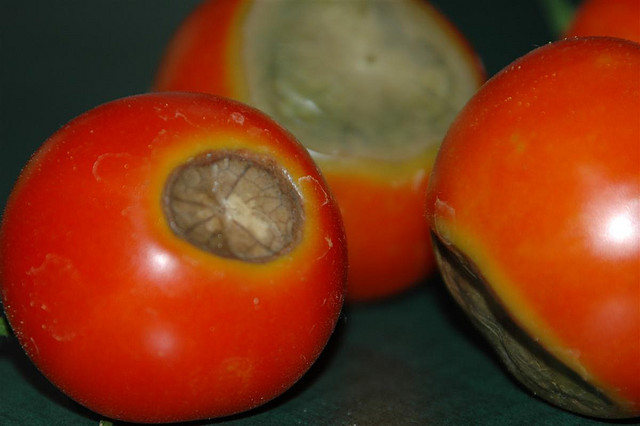Blossom End Rot in Tomatoes
Blossom end rot appears in mid to late summer just as those delicious red tomatoes begin to ripen. First symptoms resemble soft, moist spots under the skin of the green tomato, but may be overlooked. As the tomato begins to ripen, the spot enlarges, darkens, and eventually results in a soft, black, sunken area in the tomato. Many mistakenly believe that blossom end rot is the result of disease and worry that it can be passed on to other plants or to neighboring gardens. Blossom end rot is caused by a calcium deficiency and cannot be passed on to other plants.
What Causes Blossom End Rot?
Blossom end rot appears when your tomato plants don't get enough calcium, but that doesn't mean you have a calcium deficiency in your soil. Although low calcium in the soil can lead to blossom end rot that is not the most common reason. The most common reason for blossom end rot is not enough water.
Without adequate water the roots of your tomato plants cannot absorb and transport the calcium in the soil to the plant. This results in a calcium defiency in the fruit, which in turn causes blossom end rot.
Without adequate water the roots of your tomato plants cannot absorb and transport the calcium in the soil to the plant. This results in a calcium defiency in the fruit, which in turn causes blossom end rot.
How to Get Rid of Blossom End Rot
Once the tomatoes on your plants show signs of blossom end rot it is too late the save them. The only solution is to remove the affected fruits. However, it does not affect the plant. New tomatoes that form on the plant may avoid blossom end rot if you take care to water your tomatoes regularly.
How to Prevent Blossom End Rot
If your tomato plants suffer from blossom end rot due to lack of water, the key to preventing it is to provide the moisture your tomato plants need to uptake calcium. During hot, dry summers, particularly at fruiting time, tomatoes require 1 ½ inches of rain a week. When rainfall does not provide enough moisture, supplemental watering is required. Tomatoes grown in raised beds or containers may require daily watering to meet their needs, as tomatoes are heavy feeders. Water to moisten the soil to the root level whenever the soil feels dry to the touch one inch below the surface of the soil.
What else causes blossom end rot?
There are a number of other conditions that can cause blossom end rot. The University of Wisconsin - Madison attributes soggy, wet soil; extremes in soil moisture; hot, windy weather; a lack of calcium in the soil: and damage to the plant's roots as other possible causes for blossom end rot.
Tips for Preventing Blossom End Rot
The Alabama Cooperative Extension recommends several measures to control or prevent blossom end rot in tomatoes.
- Maintain a pH between 6.0 and 6.5. The pH of the soil affects the available nutrients. For best nutrient uptake for tomatoes, test the soil often and amend as recommended to maintain the pH level.
- Follow the fertilizer application rate as indicated by your soil test. Too much fertilizer at one time may contribute to blossom end rot.
- Use mulch to conserve moisture. Black or red plastic is preferred, but any mulch will do. If you choose not to use plastic mulch, straw or a layered newspapers work well, too.
- Water consistently keeping the soil moist. Do not allow soil to dry completely before watering.
- Treat plants with blossom end rot with a calcium solution. Mix 4 level tablespoons of calcium chloride to a gallon of water and apply to the soil beneath your tomatoes. In areas where temperatures reach into the upper 80's and 90's, use calcium nitrate instead.
